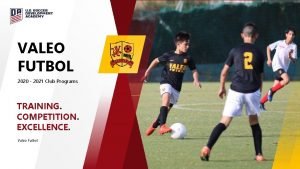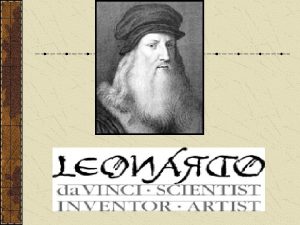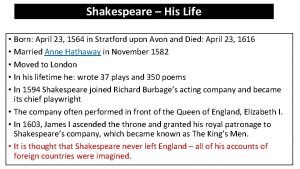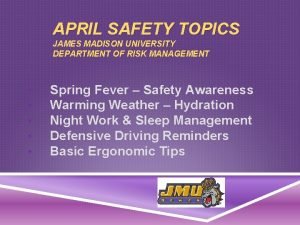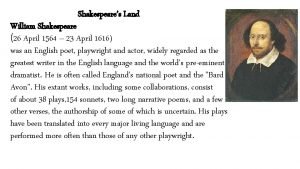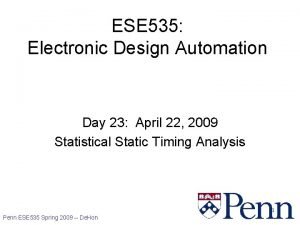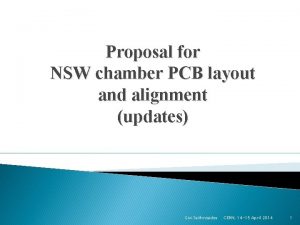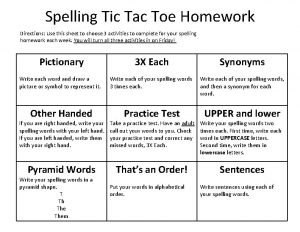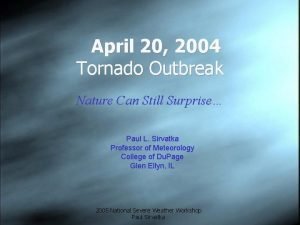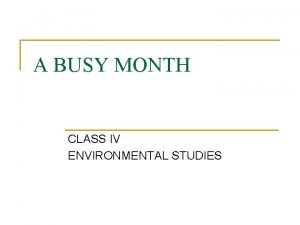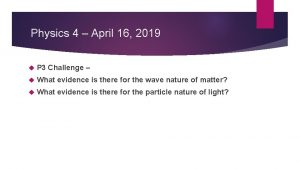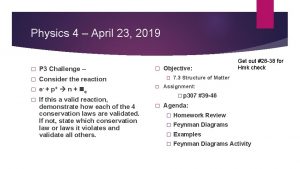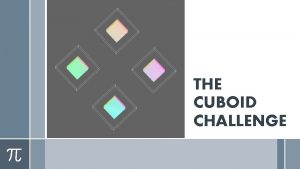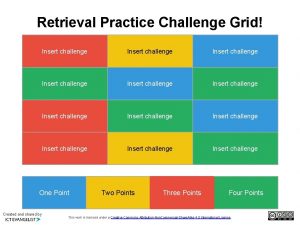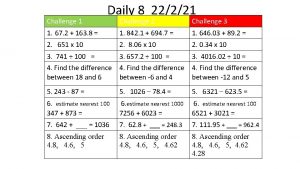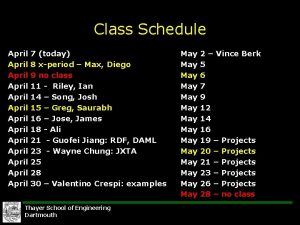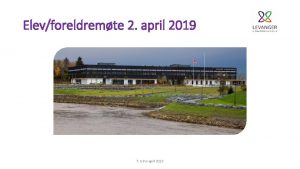Physics 2 April 23 2019 P 3 Challenge
















- Slides: 16

Physics 2 – April 23, 2019 P 3 Challenge – A 1. 50 mol gas sample is compressed isobaricly from a volume of 0. 300 m 3 to 0. 100 m 3. The gas was initially at a temperature of 300 K. • Today’s Objective: 1) Determine the Work done by the gas. 2) Determine the change in internal energy. 3) Determine the Heat for this process. • Agenda • Heat Engines • Refrigerators • Efficiency • Carnot Engine • Heat Engines • Assignment: • B. 2 p 33#32, 34 -37

Heat Engines The purpose of a heat engine is to capture thermal energy and transform it into mechanical energy. The opposite is easy: Converting mechanical energy into thermal energy is often accomplished with friction. From the laws of thermodynamics, we know that thermal energy flows from hot objects to cold objects. It is thermal energy that a heat engine can capture.

Heat Engines Heat engines usually take the form of a gas within a cylinder with a piston. The piston moves in response to state changes of the gas. The piston can do mechanical work, thus completing the transformation to mechanical energy. This is a typical car engine piston apparatus

A Sample Heat Engine Cycle Visualized Heat is added from a hot heat source (first image) QH Gas expands doing mechanical work to lift M (second image) The gas is cooled isovolumetrically (third image) Heat is expelled at lower temperature (fourth image) QC The mass is replace and the cycle repeats W QH = Q C + W

Refrigerators The second law states heat will not naturally flow from a cold object to a hot object But this transformation can be accomplished if a refrigerator does work on the system. A refrigerator is a heat engine run backwards.

Versions of the Second Law (Life’s not fair) Clausius version: It is impossible for thermal energy to flow from a cold object to a hot object without performing work. Kelvin version: In a cyclic process, it is impossible to completely convert heat into mechanical work. Note, for the opposite: Mechanical work can be completely converted into heat.

Engine Efficiency

Engine Efficiency The second law requires that there is no such thing a 100% efficient engine. The most efficient engine possible is called the Carnot engine It is a limit on the efficiency of any engine operating between any two given temperatures. So what is a Carnot engine?

The Carnot Engine Four stages of the Carnot cycle: 1 2 Isothermal compression, Qc at Tc leaves Heat expelled, Qc< 0 2 3 Adiabatic compression, increase T 3 4 Isothermal expansion QH at TH added Heat added, QH > 0 4 1 Adiabatic expansion, decrease T W = |QH | – |QC |

Carnot Efficiency (Derived) Part 1 Begin with entropy for the cycle: S =Q/T for both isothermal steps. (one positive , one negative ) S=0 for the adiabatic steps. Total S is zero because entropy is a state function 0 = QH/TH – QC/TC Difference in entropy is zero. QH/TH = QC/TC Set equal. QH/QC = TH/TC Rearrange. QC/QH = TC/TH Flip.

Carnot Efficiency (Derived) Part 2 QC/QH = TC/TH (from above) = W/QH = (QH – QC)/QH Substitute from W = QH – QC = 1 – QC/QH Rearrange. = 1 – TC/TH Substitute from above. Efficiency defined = 1 – TC/TH Result is the limit on efficiency. Efficiency = 100% only if TC = 0 K or TH = . Both absurd.

Other Engines – Stirling Engine

Other Engines – Diesel Engine

Other Engines – Otto Engine (Typical car engine)

Refrigeration

Exit Slip - Assignment Exit Slip- Sketch the Carnot cycle on a PV diagram. Label the four stages with the type of process and expansion/compression. What’s Due? (Pending assignments to complete. ) p 34#32, 34 -37 What’s Next? (How to prepare for the next day) Read 8. 1 p 314 -326 about Energy Sources (Think about groups for presentations on the five sources: Fossil fuels, Wind, Hydroelectric, Nuclear, Solar)
 Teen challenge nottingham
Teen challenge nottingham Valeo innovation challenge 2019
Valeo innovation challenge 2019 Modern physics vs classical physics
Modern physics vs classical physics University physics with modern physics fifteenth edition
University physics with modern physics fifteenth edition Physics ib ia ideas
Physics ib ia ideas April 15 1452
April 15 1452 April 23 1564
April 23 1564 Bondservants motorcycle
Bondservants motorcycle January february march april may
January february march april may 26 april 1564
26 april 1564 Earth day paragraphs
Earth day paragraphs 535 days before 23 april
535 days before 23 april Cern april fools proposal for space
Cern april fools proposal for space Spelling words for grade 2
Spelling words for grade 2 Tbss tornado
Tbss tornado April art project
April art project Why is april a busy month for birds
Why is april a busy month for birds

